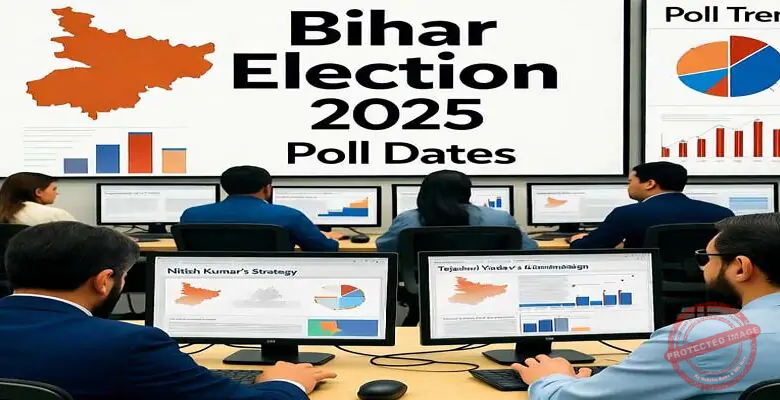
Patna (India News Reporter Staff): As the dust settles from the Election Commission of India’s (ECI) announcement of poll dates just three days ago, Bihar’s political arena is buzzing with anticipation for the 2025 Legislative Assembly elections. With voting scheduled in two phases on November 6 and 11, and results set for November 14, the state is poised for a fierce battle between the incumbent National Democratic Alliance (NDA), led by Chief Minister Nitish Kumar’s Janata Dal (United) (JD-U) and the Bharatiya Janata Party (BJP), and the opposition Mahagathbandhan (Grand Alliance), spearheaded by Tejashwi Yadav’s Rashtriya Janata Dal (RJD) in coalition with the Congress and other allies. Adding intrigue to the mix is Prashant Kishor’s Jan Suraaj Party, which is set to shake up the traditional bipolar contest by fielding candidates across all 243 seats.
The elections come at a pivotal moment for Bihar, a state long plagued by issues of unemployment, youth migration, caste dynamics, and governance inefficiencies. With an electorate of over 7.6 crore voters following the ECI’s controversial Special Intensive Revision (SIR) of electoral rolls the stakes couldn’t be higher. Early opinion polls suggest a commanding lead for the NDA, projecting it to secure 150-160 seats with a 49% vote share, a significant jump from its 37.3% in 2020. However, opposition leaders dismiss these surveys as ‘manipulated,’ vowing to capitalize on anti-incumbency against the NDA’s 20-year rule.
Poll Schedule and Voter Turnout Expectations
The ECI’s decision to conduct the polls in just two phases a departure from the five-phase 2020 elections has been welcomed by parties as a logistical boon, potentially boosting turnout. The first phase on November 6 will cover 121 constituencies, primarily in the northern and eastern regions, including Seemanchal and Mithilanchal. The second phase on November 11 will encompass the remaining 122 seats in central and southern Bihar. Model Code of Conduct (MCC) enforcement began immediately after the announcement on October 6, with Chief Election Commissioner Gyanesh Kumar emphasizing ‘free, fair, and peaceful’ polls.
Parties anticipate record voter participation, especially post-Chhath Puja (October 25-28), when millions of migrant Biharis return home. ‘This timing is a festival of democracy,’ quipped Union Minister C.R. Patil, echoing sentiments from across the spectrum. To ensure security, nearly one lakh Central Armed Police Forces (CAPF) personnel will be deployed, alongside innovations like color photographs of candidates on Electronic Voting Machine (EVM) ballot papers for better accessibility.
NDA’s Momentum: Welfare Schemes and Poll Projections
The NDA enters the fray with renewed vigor, buoyed by recent welfare initiatives like the ₹10,000 annual aid for women and youth-focused employment drives. Bihar Minister Ashok Choudhary boldly predicted over 200 seats for the alliance, claiming it would ‘break all records.’ Nitish Kumar, the alliance’s undisputed CM face as confirmed by Union Minister Giriraj Singh, is leveraging his image as a development-oriented leader who has stabilized Bihar post-Jungle Raj.
The IANS-Matrize opinion poll underscores NDA’s edge, attributing it to consolidated upper-caste and EBC (Extremely Backward Classes) support, alongside BJP’s aggressive outreach in Muslim-majority areas via narratives on infiltration and development. JD-U and BJP are yet to finalize seat-sharing, but insiders hint at a 50-50 split in the 125-seat 2020 tally. Smaller allies like the Lok Janshakti Party (Ram Vilas) have ramped up preparations, appointing Lok Sabha MP Arun Bharti as state in-charge on October 7.
Yet, challenges loom. The SIR exercise, which added over 1.5 crore new voters while deleting 60 lakh ‘ghost’ entries, has drawn Supreme Court scrutiny. A bench led by Justice Surya Kant is hearing pleas on its validity today (October 9), with petitioners alleging disenfranchisement of marginalized groups. RJD leader Tejashwi Yadav’s earlier claim of his own name being deleted was debunked by the ECI as ‘fake,’ but it fueled opposition narratives of bias.
Mahagathbandhan’s Counteroffensive: Youth and Caste Mobilization
The opposition INDIA bloc, rebranded as Mahagathbandhan, is banking on Tejashwi Yadav’s youthful charisma to dismantle the NDA’s fortress. At 36, Yadav positions himself as the ‘change maker,’ slamming the NDA for ‘20 years of crime, corruption, and misgovernance.’ The alliance’s manifesto, slated for release during the Congress Working Committee (CWC) meeting in Patna, will prioritize EBCs, promising enhanced reservations and job quotas.
Congress, a key partner, is finalizing its candidate list at the Central Election Committee (CEC) meeting today (October 8, delayed reports suggest), with leaders like Rahul Gandhi planning aggressive padyatras on unemployment and electoral reforms. Pawan Khera accused the ECI of being a ‘compromised umpire,’ citing last-minute funding delays in poll announcements. RJD chief Lalu Prasad Yadav escalated rhetoric, warning the NDA would ‘run away’ post-polls.
Caste arithmetic remains central: The MY (Muslim-Yadav) core, at 30% of voters, bolsters RJD, while outreach to EBCs and Dalits could tip scales. Udit Raj clarified that while Yadav is RJD’s CM pick, the bloc will collectively decide the face.
The Wild Card: Prashant Kishor’s Jan Suraaj
In a bombshell today, Jan Suraaj Party founder Prashant Kishor unveiled his candidate list, promising ‘full of surprises’ and positioning the outfit as a clean alternative focused on education, governance, and anti-corruption. After walking 5,000 km across Bihar in his Bihar Badlav Yatra (2022-2024), Kishor aims to contest every seat, potentially splitting anti-NDA votes. His Gandhi Maidan rally earlier this year drew massive crowds, signaling grassroots appeal.
AIMIM, led by Asaduddin Owaisi, is also entering the fray in Seemanchal and Mithilanchal (four seats each), rejecting INDIA bloc overtures and launching the ‘Seemanchal Nyay Yatra.’ Folk singer Maithili Thakur’s rumored BJP entry adds cultural flair to the NDA’s campaign.
Broader Electoral Landscape: Delhi, By-Elections, and Beyond
While Bihar dominates headlines, India’s 2025 electoral calendar is packed. Delhi’s February 5 polls pit Arvind Kejriwal’s AAP against BJP-Congress, with AAP defending its freebies model amid national scrutiny. By-elections on November 13 for eight seats across seven states/UTs Jammu & Kashmir (four), Punjab, Jharkhand, Telangana, Rajasthan, Mizoram, and Odisha will test alliances ahead of 2026 battles in Assam, West Bengal, Tamil Nadu, Kerala, and Puducherry.
The September 9 vice-presidential election saw C.P. Radhakrishnan succeed Jagdeep Dhankhar, underscoring high-level political maneuvers. Local polls, like Mumbai’s BMC, loom large, with Shiv Sena factions vying for control of India’s richest civic body.
Key Issues Shaping the Narrative
Unemployment and Migration: Bihar’s youth exodus remains a flashpoint, with INDIA bloc padyatras highlighting job scarcity.
Voter Rolls and Fairness: SIR’s ‘purification’ claims clash with disenfranchisement fears; ECI counters fake news with strict social media monitoring.
Caste and Welfare: NDA’s EBC schemes vs. opposition’s reservation hikes.
Security Measures: Anganwadi workers verifying burqa-clad voters and CCTV privacy protocols.
As campaigns intensify, Bihar’s polls could foreshadow the 2029 Lok Sabha battle. With Kishor’s wildcard and judicial oversight, this ‘sacred festival of democracy’ promises twists aplenty. Stay tuned to India News Reporter for live updates.
(India News Reporter is an independent platform committed to unbiased coverage of India’s dynamic political landscape.)








